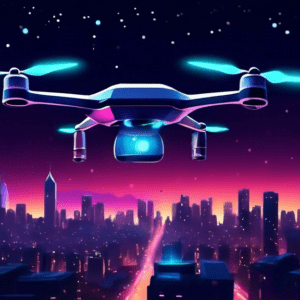Understanding Drone Lights and Visibility
Drones, also known as unmanned aerial vehicles (UAVs), have become increasingly popular for both recreational and commercial purposes. While they are easily recognizable during the day, spotting drones at night can be a challenge. Understanding how drones look and behave at night is crucial for identification and safety reasons.
Most drones are equipped with LED navigation lights to enhance visibility, especially during low-light conditions. These lights typically come in various colors, including:
- Red: Often indicates the rear of the drone.
- Green: Usually marks the right side of the drone.
- White: Commonly found on the front or top of the drone.
The configuration and color of these lights can vary depending on the drone model and manufacturer. Additionally, some drones may have additional lighting features, such as flashing or strobing lights, for enhanced visibility or specific functionalities.
Factors Influencing Drone Visibility at Night
Several factors can affect how easily a drone can be spotted at night:
- Ambient Light Conditions: In areas with significant light pollution, drone lights may be less noticeable. Conversely, in dark rural environments, even faint drone lights can stand out.
- Drone Size and Altitude: Larger drones with more powerful lights are generally easier to see than smaller ones. Similarly, drones flying at higher altitudes may appear as distant, twinkling lights.
- Weather Conditions: Fog, mist, or precipitation can significantly reduce visibility, making it harder to spot drones at night.
- Observer’s Position and Visual Acuity: The observer’s location and eyesight play a role in drone detection. A person with good vision standing on higher ground will likely spot a drone more easily than someone with poor vision at ground level.
Distinguishing Drones from Other Objects
At night, several objects in the sky can be mistaken for drones, such as:
- Aircraft: Airplanes and helicopters typically have distinct lighting patterns and often appear larger and brighter than drones.
- Stars and Planets: Celestial objects usually maintain a fixed position in the sky, while drones exhibit movement.
- Satellites: Satellites can appear as slow-moving, bright dots of light, but they generally follow a predictable path.
To differentiate drones from these objects, it’s important to observe the object’s movement patterns, light characteristics, and size. Drones often exhibit hovering or erratic movements, have distinct blinking or colored lights, and appear relatively small compared to aircraft.
Tips for Spotting Drones at Night
Here are some helpful tips for identifying drones in the night sky:
- Look for Moving Lights: Pay attention to lights that are moving independently of stars, planets, or aircraft.
- Observe Light Patterns: Note the color, blinking patterns, and intensity of the lights, as these can provide clues about the type of drone.
- Listen for Sounds: Drones often emit a buzzing or whirring sound, which can help pinpoint their location.
- Use Binoculars or a Telescope: Optical aids can enhance visibility and provide a closer look at the object in question.
- Consider the Context: Think about the location and the likelihood of drone activity in that area.
Safety and Privacy Concerns
While drone technology offers numerous benefits, it also raises safety and privacy concerns, especially at night. Drones flown recklessly or without proper lighting can pose a risk to manned aircraft and people on the ground. Additionally, drones equipped with cameras can potentially invade privacy if not operated responsibly.
It’s essential for drone operators to adhere to local regulations and fly their drones safely and ethically, particularly during nighttime hours. Individuals who observe suspicious or unsafe drone activity should report it to the appropriate authorities.
